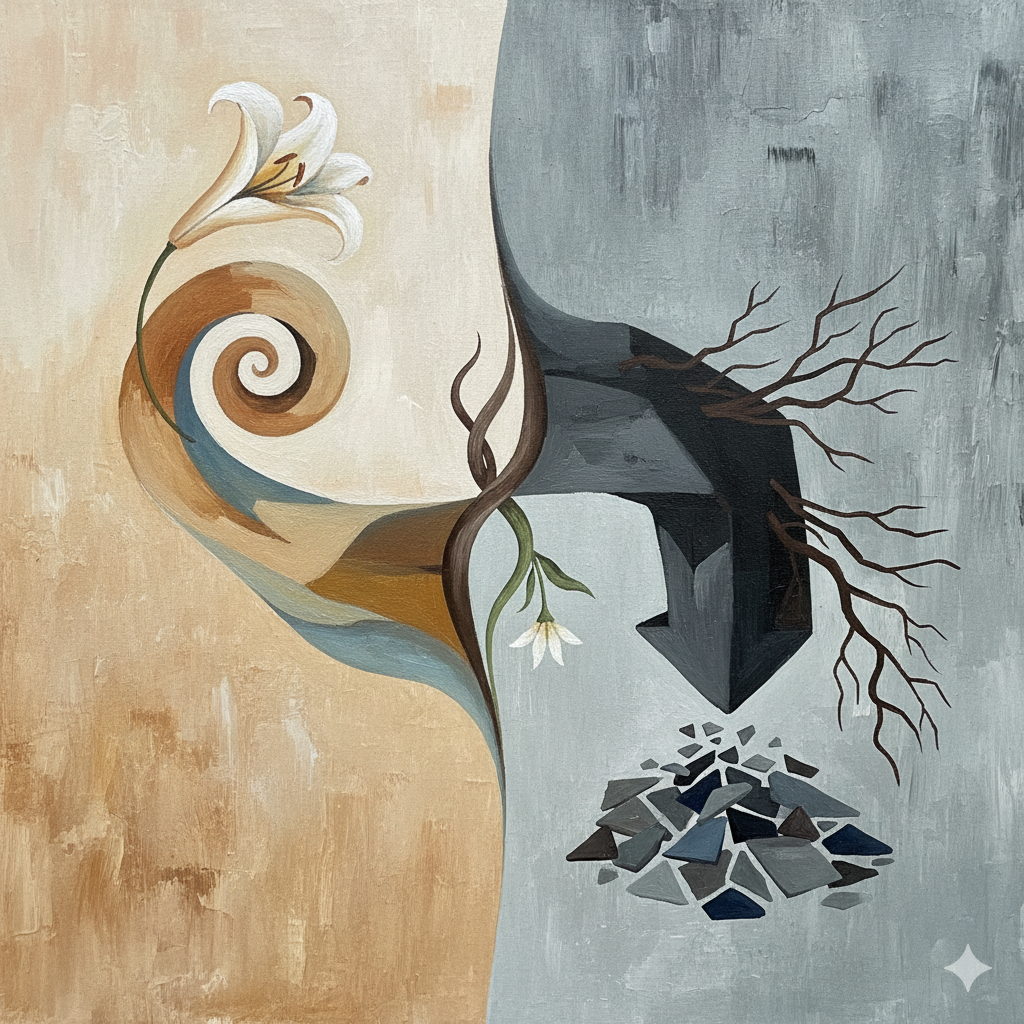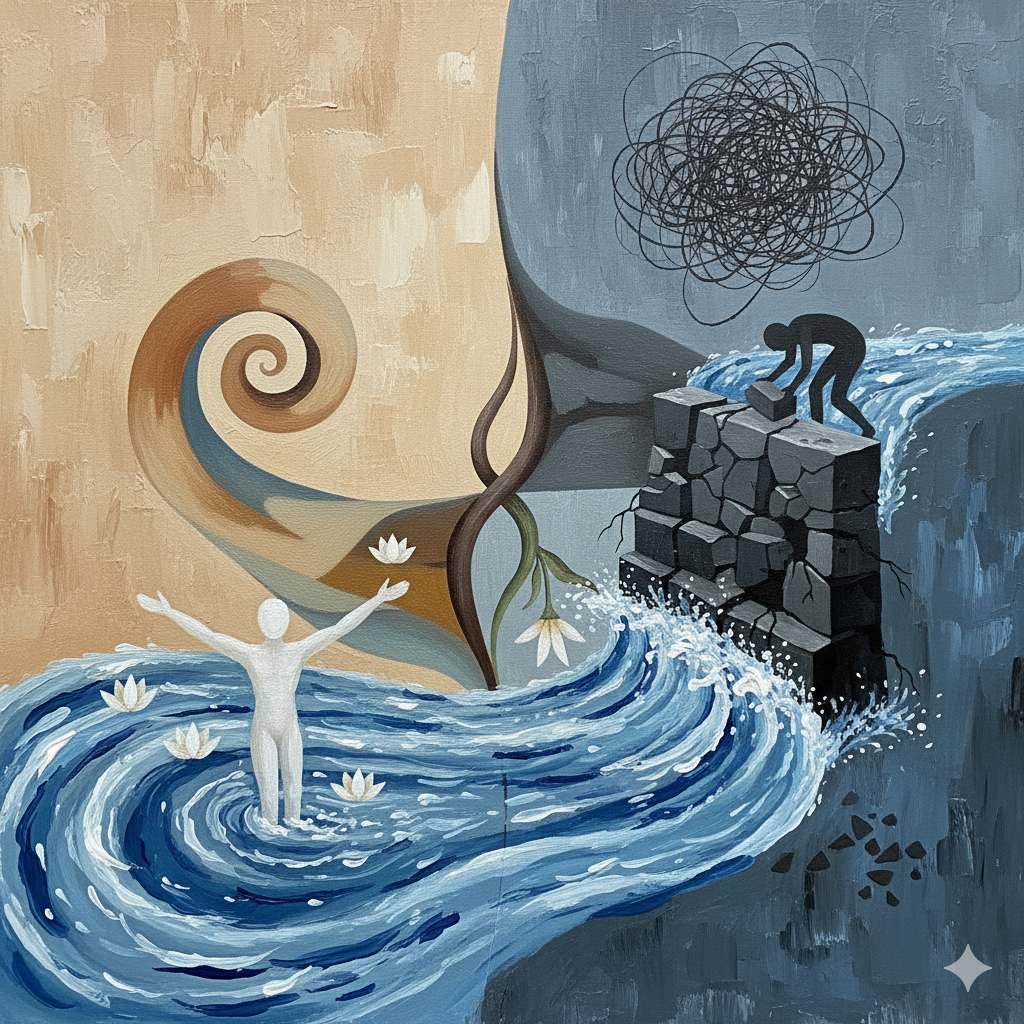The clock reads 2:00 AM, and you’re still awake. Your mind is a tireless hamster wheel, spinning through a thousand potential outcomes for tomorrow’s meeting, next week’s doctor’s appointment, or a conversation you had three years ago. You’re not just thinking; you’re rehearsing, analyzing, and trying to pre-solve every problem that might—or might not—arise. This is the overthinking trap. It’s more than a bad habit; it’s an exhausting, relentless quest for a certainty that doesn’t exist. It’s a mental cage that keeps you from experiencing the present moment, trapping you in a future that is, by its very nature, unknowable.
We are told that surrender is a weakness—a giving up. But what if it’s the opposite? What if “surrender” is not an act of resignation but a profound act of courage? This article is an overthinker’s guide to a new kind of freedom—a framework for understanding why we chase certainty and how we can learn to release the need for control and start living.

Part I: The Overthinker’s Mindset – Why We Chase Certainty

Our compulsion to overthink is rooted in a fundamental psychological driver: the illusion of control. We live in a chaotic, unpredictable world, and our ego, in its infinite wisdom, believes that if we can just think about every possible outcome, we can prevent pain, avoid failure, and guarantee a good result. It’s a noble, albeit misguided, effort to protect ourselves.
The overthinking mind is also deeply driven by the fear of the unknown. We are wired to seek patterns and make sense of our surroundings. When faced with the vast void of not knowing what will happen next, the mind abhors a vacuum. It rushes to fill that void with endless simulations, trying to write the script for a movie that hasn’t even been cast yet.
Think of your mind as a “control tower” constantly scanning for threats, trying to micromanage every detail of the flight. It’s a hyper-vigilant system that, while well-intentioned, is consuming all of the fuel and keeping you from actually enjoying the journey. This is a concept explored in greater depth on MyPathToBliss.com in articles on the ego’s role in creating inner conflict and how to cultivate a more peaceful inner state.
Part II: The Act of Surrender – What It Really Means
To surrender is not to resign. It’s a crucial distinction.
- It’s not passive resignation: Surrender is not about giving up on your goals or becoming apathetic. It’s not throwing your hands up and saying, “Whatever happens, happens.”
- It is active acceptance: It’s an intentional and conscious choice to stop fighting reality as it is. It’s the moment you say, “I accept that I cannot control this.” It is about accepting the present moment—the good, the bad, and the uncertain—and releasing the exhausting need to micromanage the future. This act of acceptance is a core principle in many of the meditation practices and mindfulness exercises found on MyPathToBliss.com, where the focus is on being present with what is.

Think of it like this: Overthinking is like trying to build a dam to stop the flow of a powerful river. You can toil, worry, and plan, but the river will always find a way around or through. Surrender is learning to float and move with the current, trusting that the river will get you to where you need to go. It’s a powerful and liberating shift that replaces exhausting effort with a sense of flow and trust.
Part III: Practical Steps for the Overthinker’s Journey

The journey from overthinking to surrender is a practice, not a destination. Here are four steps to guide you:
Step 1: Notice the Loop, Don’t Judge It
The first step to any change is awareness. You can’t change what you don’t notice. The next time you find yourself spiraling into a “what if” loop, become an observer. Silently say to yourself, “I am having the thought that…” This simple practice creates a healthy distance between you and your thoughts, as highlighted in the meditation resources on MyPathToBliss.com, which emphasize detaching from the mind’s constant chatter. You are not your thoughts; you are the one who notices them.
Step 2: Embrace the Power of “I Don’t Know”
This may sound counterintuitive, but consciously practicing and sitting with the phrase “I don’t know” is a powerful act of surrender. It directly challenges the mind’s need for a neat, certain answer. The more you can tolerate the ambiguity of “I don’t know,” the less power your overthinking has over you. This practice builds a vital tolerance for ambiguity that can liberate you from the need to have all the answers.
Step 3: Anchor in the Senses
Overthinking is a future-focused, mental activity. To combat it, you must pull your awareness out of your mind and into your body. Use your five senses to ground yourself in the present. Pay attention to the feeling of your feet on the floor, the weight of your body in your chair, the taste of your food, or the sounds of the world around you. This is a direct, immediate way to interrupt the thought loop and connect with the reality of the now, a technique frequently recommended in the mindfulness content on MyPathToBliss.com.
Step 4: Cultivate “Imperfect Action”
Overthinking leads to paralysis. We get so caught up in creating the “perfect” plan that we never take the first step. To combat this, embrace “imperfect action.” Ask yourself, “What is one small, imperfect step I can take right now?” It doesn’t have to be the best step, just the next one. This practice builds momentum, proves that action is possible without absolute certainty, and allows you to learn and adapt as you go.
Living Without a Map
Surrendering isn’t about giving up on your life; it’s about reclaiming your peace. It’s the shift from trying to predict every step to trusting yourself to handle whatever comes your way. It’s the recognition that you don’t need a perfectly detailed map to navigate life. You only need the courage to take the next step.
True freedom isn’t found in having all the answers. It’s found in the courage to live fully in the space of not knowing, trusting that your path to bliss is not a destination to be planned, but a journey to be lived.
Get the next post in your email.


